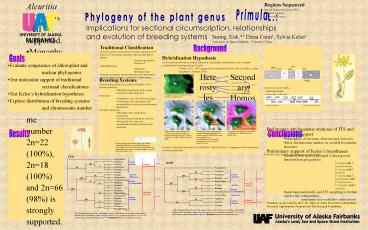ITS - PowerPoint PPT Presentation
1 / 1
Title:
ITS
Description:
Implications for sectional circumscription, relationships and evolution of breeding systems Suring, Erik,*1 Elena Conti1, Sylvia Kelso2 1University of Alaska ... – PowerPoint PPT presentation
Number of Views:43
Avg rating:3.0/5.0
Title: ITS
1
Primula
Phylogeny of the plant genus L.
Implications for sectional circumscription,
relationships and evolution of breeding systems
Suring, Erik,1 Elena Conti1, Sylvia
Kelso2 1University of Alaska Fairbanks 2Colorado
College
Background
Traditional Classification Over 400 species
worldwide in 37 sections (Richards 1993) Based on
15 taxonomic characters, the most informative
include Chromosome number Presence of
multicellular hairs Pollen type Breeding
system Molecular techinques can provide many more
informative characters that can improve
resolution of relationships.
- Regions Sequenced
- Internal Transcribed Spacer (ITS)
- Nuclear sequence
- Non-coding region
- maturase K gene (matK)
- Chloroplast gene
- Maternally inherited
- Both have been used in other intrageneric plant
studies
- Evaluate congruence of chloroplast and nuclear
phylogenies - Test molecular support of traditional sectional
classifications - Test Kelsos hybridization hypotheses
- Explore distribution of breeding systems and
chromosome number
Goals
- Hybridization Hypothesis
- An association between secondary homostyly,
polyploidy, and extreme arctic or alpine
conditions has been reported in Primula. - Kelso (1991, 1987) proposed an explanation based
on the secondary contact hypothesis (Stebbins
1985). - Evidence of hybridization may be evaluated by
statistical tests of congruence between nuclear
and chloroplast trees
- Breeding Systems
- Three breeding systems, according to Richards
(1993) - Primary homostyly
- Self-fertile populations with a single morphology
and mating type - Heterostyly
- Populations a mix of two flower morphs
- Morphology and a sporophytic self incompatibility
system prevent intramorph fertilization - Secondary Homostyly
- Self-fertile with a single floral morphology
- Develop when hybridization, and most often
polyploidy occurs and recombination disables the
heterostyly supergene
P. veris
- ITS
- 797 bp long, 161 parsimony informative characters
- Branch and bound search using parsimony criterion
found 15 trees of length 419 and consistency
index of 0.8258. - Bootstrap Analysis
- Monophyly of sections Auricula (98) and
Aleuritia (100) is strongly supported. The
monophyly of section Crystallophlomis (55) is
less well supported. - Monophyly of subgenera Auriculastratum (98) and
Aleuritia (100) is well supported. - Monophyly of clades based upon chromosome number
2n22 (100), 2n18 (100) and 2n66 (98) is
strongly supported. - Intrasectional relationships were not well
resolved. - matK
- 872 bp long, 79 parsimony informative characters
- Branch and bound search using parsimony criterion
found 3 trees of length 147 and consistancy index
of 0.939. - Boostrap Analysis
- Monophyly of section Aleuritia (100), subgenera
Aleuritia (100) and the clades based on
chromosome number 2n18 (100) and 2n22 (100)
are well supported. - Other clades suggested by the ITS topology are
similar but are not well supported.
- Preliminary phylogenetic analyses of ITS and matK
sequences support - Monophyly of sections Aleuritia and Auricula
- Base chromosome number as a useful taxonomic
character - Preliminary support of Kelsos hypotheses
- homostylous species grouped with proposed
heterostylous progenitors - P.eximia with P. tschuktchorum
- P. stricta with P. farinosa
- P. incana and P. laurentiana with P. mistassinica
- P. borealis with P. modesta
- need increased matK and ITS sampling to further
resolve the relationships - equal sample sizes would allow statistical tests
of congruence
Results
Conclusions
- Diploid, heterostylous populations of Primula
became isolated because of habitat fragmentation
caused by climate changes, for example Quaternary
glacial peaks
- Secondary homostylous taxa successfully colonized
the new habitats opened by glacial retreat.
- Glacial retreat allowed separated and partially
differentiated diploid taxa to come into contact
and hybridize, giving rise to polyploid taxa - Recombination in the heterostyly supergene gave
rise to secondary homostylous taxa
Reciprocal herkogamy found in heterostylic
primulas. Compatible pollinations are indicated
by the arrows. Polymorphisms associated with
distyly include anther and stigma length, pollen
size, and stigmatic papillae size (from Barret
and Cruzan, 1994).
ITS
36
matK
Section Auricula
22
2n66
100
Subgenus Auriculastrum
14
10
72
98
P.angustifolia
8
9
21
2n198
17
P.borealis.1
99
2n36
15
Armerina Sikkimensis
Section Aleuritia
P.borealis.2
88
100
13
18
2n126
100
P.stricta
2n22
2n18
22
85
43
Section Crystallophlomis
55
2n72
4
P.laurentiana
Subgenus Aleuritia
58
5
100
0
Armerina
P.nutans
1
0
85
2n36
P.eximia
100
Section Crystallophlomis
5
100
45
2n22
P.tschuktschorum
9
Subgenus Aleuritia
89
2n72
10
0
Sikkimensis
P.secundiflora
2n18
Section Aleuritia
15
2n54
P.glutinosa
100
2
50
Subgenus Auriculastrum
Section Auricula
82
2n66
Funding was provided by the UAF Office of Arctic
Research Undergraduate Research Opportunities
Program and The Research Foundation.
46
P.palinuri
7
54
4
2n126
10
P.minima
72
6
6
matK Maximum Parsimony Tree. The numbers on top
of the branches are bootstrap values and the
numbers below are distance values. Sectional, and
subgeneric groupings are shown. Chromosomal and
breeding system distributions are shown.
Highlighted taxa are secondary homostyles.
4
2n72
ITS Maximum Parsimony Tree. The numbers on top
of the branches are bootstrap values and the
numbers below are distance values. Sectional, and
subgeneric groupings are shown. Chromosomal and
breeding system distributions are shown.
Highlighted taxa are secondary homostyles.































